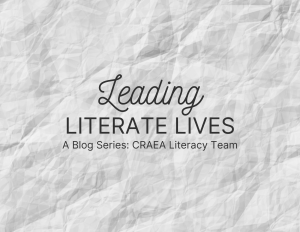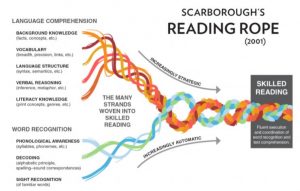
There is no comprehension strategy strong enough to compensate for the fact that you can’t read the words. -Anita Archer
Defining the Science of Reading
The Science of Reading is decades of research and knowledge about how children learn to read. Years of empirical studies give us a deeper understanding of our students’ processes and skills to understand the meaning of printed words. It is a body of research conducted over 50 years that has expanded and changed. The information we’ve uncovered about literacy acquisition should be incorporated into our daily instructional routines and practices. As we continue to learn and grow we can consider small shifts we can make to ensure our instruction is the most impactful.
This post cannot cover the ‘scope’ of the research around literacy learning. Therefore, we have decided to focus specifically on reading and the well-researched components that are required to become a strategic reader.
In 2001, Dr. Hollis Scarborough created an infographic depicting the complex processes required to understand printed text, called The Reading Rope. Notice the importance of language comprehension AND word recognition in the process of learning to read.

As a Secondary Teacher, Why Should I Be Aware of The Science of Reading?
The better we understand literacy research the better we are able to address the needs of all of our learners. As we are tasked with meeting the needs of a wide range of learners, we need to be aware of all the components that make up reading comprehension in order to pinpoint lagging skills.
First and foremost, children must remain engaged in their work by giving them a choice and a voice which creates opportunities for a deeper and more meaningful learning experience. Below, the components of Scarborough’s Rope are further explained through possible classroom practices:
Classroom Practices That Build Language Comprehension
- Building Background Knowledge: Watch a brief video on the topic before reading about. Make connections with other disciplines.
- Vocabulary: Explicitly teach vocabulary words and promote lots of discourse in your classroom.
- Language Structure: Explicitly teach morphology and promote lots of discourse in your classroom.
- Verbal Reasoning: Explicit model comprehension strategies and promote lots of discourse in your classroom.
- Literacy Knowledge: Teach different text types and model how to approach these types of texts.
Word Recognition for Students With Lagging Skills:
Chances are, secondary students who are struggling with comprehension may actually have lagging foundational skills. These students may have never fully developed the basic reading skills necessary for navigating and understanding complex text and the older students get, the less foundational skills are taught. Without these foundational skills, students may have difficulty decoding words, leading to difficulties in comprehending text as a whole.
- Phonological Awareness: Phonological Awareness is the ability to hear and manipulate the sounds of a language.
- Decoding: Decoding is matching sounds to symbols or letters.
- Sight Recognition: Bank of words that can be instantly and effortlessly recognized.
To devise an instructional plan for these lagging skills it would be necessary to assess current skill level and plan accordingly. For additional resources on planning for instruction check out the links below.
Links to additional resources
- What Works Clearinghouse
- Louisiana Believes Video
- LMS Microcredential: “What is the Science of Reading“
- https://secondaryreadingworkshop.com/science-of-reading-in-secondary/
For more information, please reach out to your CRAEA Literacy Coordinator.
References
Scarborough, H. S. (2001). Connecting early language and literacy to later reading (dis)abilities: Evidence, theory, and practice. In S. Neuman & D. Dickinson (Eds.), Handbook for research in early literacy (pp. 97-110). New York: Guilford Press.
